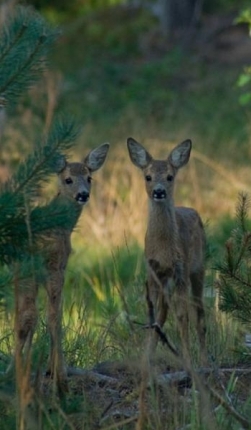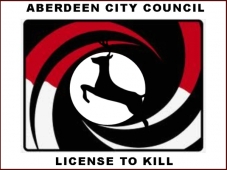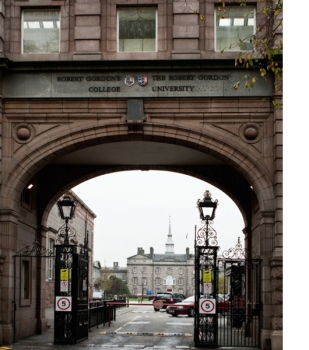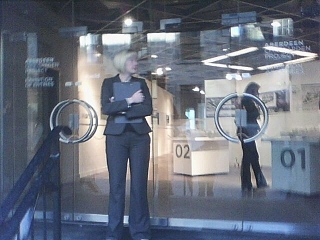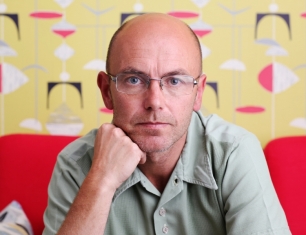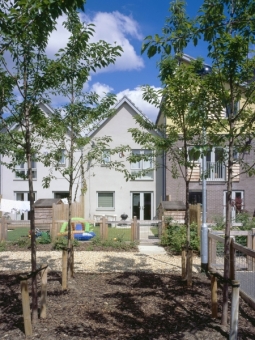An Editorial and suggestion for a better plan for Tullos Hill. By Suzanne Kelly.
For nearly a year many people have attempted to get Aberdeen City Council to see sense over its planned cull of the Tullos Hill roe deer. The City insists the archaeology-rich, bio diverse meadows of Tullos must be turned into an 89,000 tree forest. They will not budge.
It makes no difference that the area has a history of arson and that there are explosion hazard sites on the hill (there is a dangerous old waste tip and escaping gas areas, protected by warning signs and barbed wire fence).
Aileen Malone (Liberal Democrat Councillor), Valerie Watts (Chief Executive), Pete Leonard (Officer) and Ian Tallboys (ranger) have all been corresponding with me and others. These emails often contradict other correspondence.
They also often quote an unnamed expert or two, and the writers refuse to so much as listen to any dissenting expert opinions, even if offered free of charge. This puts to rest any feeble excuse that there is a robust scientific approach to the hill’s future.
For me, there are just too many contradictions, omissions and flawed logic for the plan and its supporters to retain any credibility on this matter. It is time to examine some of the conflicting information these four people have been offering. It is also time to examine whether or not everything they say is accurate, and to ask why we have spent council time, money and energy on this plan.
For what we were once told was a ‘cost-neutral.’ sound plan ready to implement turns out to be nothing more than a draft proposal to the Forestry Commission. But more importantly it is time to secure Tullos Hill’s future and preserve what we already have: a beautiful, changing meadowland and grassland habitat which supports animals including deer.
Who has said and done what? To completely detail all of the misinformation and seemingly misleading statements would require a book. Instead I prepared a chart which highlights some of the contradictions. It can be accessed here, but is in no way exhaustive of the ever-changing information slowly leaking out concerning this scheme. Click Link
Past articles have highlighted that £43,800 was already wasted on a failed tree planting at Tullos. Even though I formally asked the City to clarify this had happened, Valerie Watts at first effectively denied any such thing had occurred. When presented with proof positive (in the form of a letter from the Forestry Commisison demanding the £43,800) Ms Watts said that ‘there was no relation’ between my request to clarify that money was owed – and that since I asked my question in May and the bill was paid in March, there was no need to clarify the position. The public and I beg to differ.
New Revelations
The Evening Express (itself accused by Valerie Watts alongside the P&J of getting the story wrong over time) revealed that there is actually no budget in place. All this time Aileen Malone and others have insisted the scheme is cost neutral and that we must shoot the deer as it would be the most cost effective way to grow trees.
Never mind that the scheme will destroy what is already on the hill or that this argument is wholly immoral – which led to the public outcry – there is no money in place. This one revelation alone calls into question reports issued by the City which claim the scheme had funding. It does not.
Asking the City to clarify the funding picture has so far been fruitless, but I have since learned that only a draft application for the tree scheme is in place. All the press releases and sweeping statements about the trees are, just a little bit, premature. Months ago I asked Ms Watts for the financials. She eventually wrote back to ask what I meant – which in case you were wondering meant the financials for the tree plan (money in, money out, costs, expenses).
Rather than answering me, she has sent my question (months after first being asked) to her Freedom of Information department. The Council recently complained that its FOI staff were inundated with work: perhaps those who hold information should release it without the need to burden this department.
( Stop Press – Financial information. Click Link )
Mystery of the Missing Postcards
With funds kindly raised largely by Lush (which had a cycle event – their team from Edinburgh gave up personal time and cycled to Aberdeen to highlight the deer’s plight), some dramatic, effective pre-printed postcards were produced.
They were so popular that a re-print was done, and 700 such postcards were made in all.
I have some photos of the backs of pre-printed postcards. These were signed after a meeting of anti-cull people was held at the end of September. A few nights later, I obtained more cards from other people, and handed a total of 63 cards protesting the cull to a security guard at the City’s Town House. The guard told me:
“we got loads of these in this week, and even more came in the week before.”
In a recent letter to me, Ms Watts says that 35 postcards were received.
Ms Watts and the City somehow are not getting items sent through the regular post: Torry Community Council’s letter protesting the cull never arrived, as Watts confirmed in the same letter which mentions the postcards. I spoke to the Torry CC Secretary on 2 November, and she said ‘the letter was definitely sent, but the City didn’t receive it.’ This letter was the result of Torry’s CC voting unanimously to protest the cull and complain about how the whole affair was handled.
Perhaps I can understand the City not receiving post through the mail – something the City claimed to have posted to me never arrived, and an email they sent never showed up either (which conveniently for them put the cull protest off by weeks). However, I most definitely dropped 63 signed postcards from different individuals at the Town House: there is no logical excuse for the cards ‘disappearing’.
‘The Media is to blame’ (Really?)
The City’s position, according to its Chief Executive Ms Watts is as follows (from two different letters):-
“Aberdeen City Council has no control over how the media report Council meetings. In this case the media did not accurately report on decisions of the Committee and have continued to publish inaccurate information about the project. They have published their interpretation of the committee decisions.”
I do not personally believe that the reports I read in print or saw on television misconstrued the Committee’s decisions at the time it decided to press ahead with the cull, having read the committee reports and minutes.
In an even stronger attack on the media, last week Valerie Watts wrote to me the following, which I believe must have been based in part on the Evening Express front page article of 30 September by you, Mr Ewen:
“In terms of media coverage, Aberdeen City Council’s Media Team has on several occasions sought to correct the media’s assumption that our deer management programme would necessarily begin on or around the first day of the season for controlling the numbers of roe deer hinds.
“Both the Evening Express and the Press & Journal have reported that the roe hind seasons begins on 01 October – the season in fact commences on 21 October – and that deer management would begin on or near that date. Both newspapers were informed as to the correct date of the start of the season and were reminded that no date had in fact been set by the Council for the start of our management programme.
“The newspapers were also informed that their stories had raised false expectations that the start of deer management was imminent. They have been told that details will only be finalised once funding is in place and when the trees are about to be planted.”
I spoke to an Evening Express reporter on the 2nd of November about this issue; they replied
“I am in contact very often with the City’s media team, and it’s never come up.”
Perhaps the media is misleading me, as Ms Watts would have me believe, or perhaps the media team has not contacted reporters who write about the cull. In fact, now that I have published a number of articles on the cull, I can confirm the city has never once been in touch to suggest I have any facts wrong.
Moving on: to a Meadow
This week the Housing & Environment Committee met (2 November); Neil Cooney called the whole dubious scheme into question. Not only did he bring up the absolute lack of funding, but he also mentioned the soil report.
To say that Tullos is not ideal for tree planting is accurate. But the City never did publicise this additional fact: they have been asked to spray weed killer on Tullos for two to three years until the trees are established. There is no detail on the cost, damage potential for plants and animals, and even potential health risks for people.
Neil Cooney, many concerned residents and I are now working to get the hill preserved (or perhaps even enhanced) as a meadow. If you have ever seen the Dame’s Violets in bloom you would wonder why anyone would disturb their balance. The gorse (being unceremoniously ripped out on occasion – and burnt) is essential for many forms of wildlife year round, providing food and shelter.
It is this gorse Ian Tallboys says is of limited value and which he wants ripped out. At present there are beautiful forms of delicate (probably rather rare) fungi growing – any change in soil PH balance could kill them, not to mention the damage planting would do to the underground network from which these mushrooms grow.
You probably know there are three Bronze Age Cairns on the hill; they are set off in a striking fashion.
A forest will forever obscure them and the amazing views of the city and sea. You might not know that over a dozen other smaller sites, many bronze age, are in the planting area. It is unclear whether the appropriate government agencies have been contacted about this aspect of the tree plan.
If you want more information on why a meadow is such a better idea for Tullos, then please read the article on meadows in this issue of Aberdeen Voice. ( Click link )
Also – remember that we are about to build hundreds of homes and a football stadium where we currently have meadows. This will spell the end for the wildlife that depended on these fields – to also change Tullos is an environmental disaster as far as I am concerned. Perhaps now that the City’s ranger service is expected to turn a profit (yes, they are told to generate income streams with the very odd finance system at work in our city), they hope to have timber income from the trees – which according to the aforementioned soil report, will never achieve maturity.
How much quicker, efficient and simpler it would be to conduct nature tours of what is an amazing hill. Environmental tourism is a growing area, and we with our resources should be getting on it.
This article and the accompanying table contain my personal opinions as well as quotations from the City’s documents. I invite you to draw your own conclusions, to ask the City and Aileen Malone (once so keen to be quoted in press releases) why a meadow is not the best future for this hill.
If you would like to help lobby for a meadow, please get in touch via the Aberdeen Voice for further information. We can avert an environmental tragedy if we act now. This plan is still in a very early stage – but we will come up with a plan that will support the existing flora, fauna – and especially the deer.
